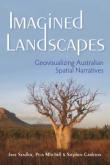AustLit
Latest Issues
AbstractHistoryArchive Description
'Imagined Landscapes teams geocritical analysis with digital visualization techniques to map and interrogate films, novels, and plays in which space and place figure prominently. Drawing upon A Cultural Atlas of Australia, a database-driven interactive digital map that can be used to identify patterns of representation in Australia’s cultural landscape, the book presents an integrated perspective on the translation of space across narrative forms and pioneers new ways of seeing and understanding landscape. It offers fresh insights on cultural topography and spatial history by examining the technical and conceptual challenges of georeferencing fictional and fictionalized places in narratives. Among the items discussed are Wake in Fright, a novel by Kenneth Cook, adapted iconically to the screen and recently onto the stage; the Australian North as a mythic space; spatial and temporal narrative shifts in retellings of the story of Alexander Pearce, a convict who gained notoriety for resorting to cannibalism after escaping from a remote Tasmanian penal colony; travel narratives and road movies set in Western Australia; and the challenges and spatial politics of mapping spaces for which there are no coordinates.' (Publication summary)
Notes
-
Table of Contents:
Introduction: Geocriticism’s Disciplinary Boundaries
Acknowledgments
1. Remediating Space: Adaptation and Narrative Geography
2. Cultural Topography and Mythic Space: Australia’s North as Gothic Space
3. Spatial History: Mapping Narrative Perceptions of Place over Time
4. Mobility and Travel Narratives: Geovisualizing the Cultural Politics of Belonging to the Land
5. Terra Incognita: Mapping the Uncertain and the Unknown
Bibliography
Index
-
Dedication: This book is dedicated to renowned spatial humanities scholar P.J. Carstell, and to our traveling companions Hannah, Alex, Amara, and Hugo.
Publication Details of Only Known VersionEarliest 2 Known Versions of
Works about this Work
-
[Review Essay] Imagined Landscapes : Geovisualizing Australian Spatial Narratives
2017
single work
essay
— Appears in: Social and Cultural Geography , vol. 18 no. 6 2017; (p. 888-889)'In this fine piece of truly interdisciplinary work, geospatial technology is employed as a spatial hermeneutic tool to extirpate the mythical pasts haunting the Australian post-colonial imagination. Such fictions were invented from distant readings of the vast expanses of the continent’s regional sociocultural and physical geographies. The authors interrogate literary, historical and cinematic readings of these reified landscapes and as a result, cultural topography, spatial history and the study of fictional narratives are engaged with geo-visual technology in unique, innovative and insightful ways. The work’s conceptual foundation stone, it seems, is Paul Carter’s The Road to Botany Bay: An Essay in Spatial History where the distinction between the ‘geographer’s space’ and ‘spatial history’ is clearly delineated.' (Introduction)
-
[Review Essay] Imagined Landscapes : Geovisualizing Australian Spatial Narratives
2017
single work
essay
— Appears in: Social and Cultural Geography , vol. 18 no. 6 2017; (p. 888-889)'In this fine piece of truly interdisciplinary work, geospatial technology is employed as a spatial hermeneutic tool to extirpate the mythical pasts haunting the Australian post-colonial imagination. Such fictions were invented from distant readings of the vast expanses of the continent’s regional sociocultural and physical geographies. The authors interrogate literary, historical and cinematic readings of these reified landscapes and as a result, cultural topography, spatial history and the study of fictional narratives are engaged with geo-visual technology in unique, innovative and insightful ways. The work’s conceptual foundation stone, it seems, is Paul Carter’s The Road to Botany Bay: An Essay in Spatial History where the distinction between the ‘geographer’s space’ and ‘spatial history’ is clearly delineated.' (Introduction)




